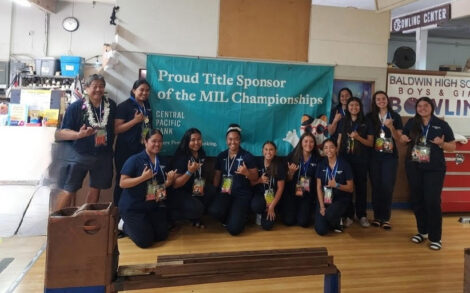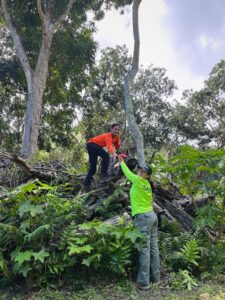TV special to highlight endangered native Maui bird
The Maui News
A television special featuring an endangered native bird found only on Maui will debut on KHON2 this evening, the state Department of Land and Natural Resources announced.
Shot entirely on Maui, “Saving Kiwikiu — Maui parrotbill on the brink,” tells the story of the small yellow honeycreepers that live only in high-elevation forests on windward Haleakala. The bird’s estimated population has dwindled to fewer than 150 individuals, putting them at a high risk of going extinct within a few years.
The documentary will air at 9:30 p.m. today on KHON2, with a replay on Channel 2 sister station KHII at 8 p.m. Sunday.
“We are excited to help tell the story of this at-risk native bird and of the people involved in trying to save it,” said Kristina Lockwood, general manager of KHON/KHII. “It’s a remarkable story, and unfortunately one that is indicative of the tremendous threats many native species in Hawaii are facing now and into the future.”
The Maui Forest Bird Recovery Project and experts from the DLNR Division of Forestry and Wildlife, the U.S. Fish and Wildlife Service, American Bird Conservancy and other supporters have spent more than a decade developing and executing plans to save the kiwikiu from the fate experienced by hundreds of other native Hawaiian animals, plants and insects, DLNR said in a news release Monday.
“Once we lose them, they’re gone forever,” said Hanna Mounce of the Maui Forest Bird Recovery Project.
A major project in the fall of 2019 aimed to move a dozen or so birds from Hanawi, on the windward side of Haleakala, to the Nakula Natural Area reserve on the leeward side in hopes of creating a new kiwikiu population in the restored Nakula forest.
Habitat improvements to make the area suitable and attractive for kiwikiu included the planting of more than 260,000 native plants and trees, the removal of nonnative predators and fencing to keep habitat-destroying goats and pigs out, DLNR said.
Two teams, one at Hanawi to capture birds for translocation to Nakula, and another to release and monitor the birds, carefully coordinated their efforts over several weeks.
However, the program was halted after nine of the relocated birds died of avian malaria.
Conservation officials have since announced plans to transport 30 kiwikiu to Mainland zoos to keep them alive while a safe release site is sought.
The “Saving Kiwikiu” documentary will highlight the experiences of people working to protect the birds.
“In addition to seeing, firsthand, through the experiences of all the dedicated and passionate professionals working on the kiwikiu project, viewers will see remote areas of Hawaii that few of us get to visit,” said DLNR Chairwoman Suzanne Case, who previewed the TV special. “This production really drives home not only the beauty of our landscapes, our native birds and plants, but how critical it is that we do everything in our power to protect all these unique and special creatures and their ecosystems.”
The TV broadcasts are made possible by the American Bird Conservancy and the National Fish and Wildlife Foundation, according to the news release.



